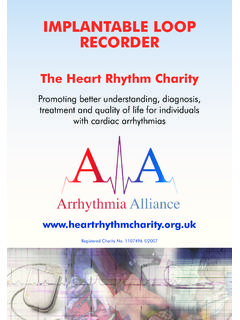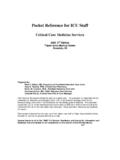Transcription of Physical exercise and advice for pat with an ICD …
1 Physical activity and exercise advice for patients with an ICDThe Heart Rhythm CharityPromoting better understanding, diagnosis, treatment and quality of life for individuals with cardiac arrhy thmiasPhysical activity and exercise advice for patients with an Charity No. 1107496 2008 Introduction to Physical activity and exercise advice for patients with an ICDAs a result of suffering from, or being at risk from, serious hear t rhy thmdisturbances (arrhy thmia), you have been f itted with an Implantable Cardiover ter Def ibrillator or ICD. One of the most impor tant reasons for you having thisdevice is to keep you as healthy, active and independent as cardiologist, arrhy thmia/ICD nurse and/or cardiac physiologists will have given you information regarding how the device works, what to do if it goes off and should have advised you regarding matters such as driving and equipment that may interfere with your device. Please see also our ICD patient information booklet A question that often does not come up for a while after the ICD is f itted, however, is can I take exercise , and if so, how much and what sor t?
2 Arrhythmia Alliance (A-A) is a coalition of charities, patient groups, patients, carers, medical groups and allied groups remain independent, however, work together under theA-A umbrella to promote timely and effective diagnosis and treatment of arrhy suppor ts and promotes the aims and objectives of the individual it safe to exercise ?How might exercise affect my ICD?Is there any exercise I def initely can t do?So what can I do?Arrhy thmia Alliance patient booklets are reviewed booklet will be nex t updated April 2009, if you have any comments or suggestions please contact of termsAblationA procedure performed by an electrophysiologist to clear a small volume of cardiac abnormal hear t rhy Top chambers of the hear t that receive blood from the body and from the lungs. The atriumis where the hear t s natural pacemaker (sino atrial node) can be found. AV Node Par t of the electrical pathway between the atria and the are f ine wires which are passed through tubes and are positioned within the hear ibrillationThe use of a higher energy shock to stopfast hear t rhy A cardiologist who has specialised in the electrical side of the hear t, meaning the hear t s rhy thm.
3 Sinus NodeThis is the natural pacemaker of the hear Supraventricular tachycardia abnormal hear t rhy thm arising from the upper chambers of the hear Fast hear t beat. Ventricular Fibrillation (VF)A fast, dangerous hear t rhy thm which causes the hear t to stop pumping. This rhy thm needs a shock to stop it and return the hear t back to a normal rhy thm. A cardiac arrest can soon follow if the rhy thm is not treated quickly with a Tachycardia (VT)A fast rhy thm which causes the hear t to pump less eff iciently, and can lead to dizziness, fainting and unconsciousness. If not treated with medication or an electric shock, the rhy thm can lead to ventricular f it safe to exercise ?The simple answer to this question is yes, but the full answer is inf luenced by the cause and type of your arrhy thmia and the type of exercise you perform. The likelihood of arrhy thmia during exercise is very small but when it occurs it is sometimes linked to an abnormality of hear t function and not the presence of an ICD.
4 This is especially true if you have suffered considerable damage to your hear t as a result of a hear t attack (myocardial infarction) or have a hear t muscle disease cardiomyopathy. The likelihood of arrhy thmia is no greater during moderate intensity aerobic exercise than during resting but there are cer tain types of exercise that increase the risk of arrhy thmias. If you exercise hard, from rest, without a warm-up and immediately cease exercise , without a cool down or active recovery period, you increase the likelihood of arrhy thmia. In cardiac rehabilitation exercise programmes, worldwide, where a warm-up and cool down are the norm, arrhy thmia rarely ever might exercise affect my ICD?Your ICD detects abnormal hear t rhy thms in a number of ways, one of which relates to the speed of the hear t during the arrhy thmia. Most arrhy thmias treated with ICDs will be signif icantly faster than your normal hear t rate would reach, even with strenuous exercise .
5 Occasionally, however, the ICD needs to be programmed to recognise abnormal hear t rates that are close to those that can be achieved with exercise . For this reason, it is wor thwhile to check how your ICD is programmed before under taking any thing other than recreational exercise or exercise to lose weight; your cardiologist, arrhy thmia nurse or cardiac physiologist can advise you about how high you can safely raise your hear t rate. If you are concerned about your safe exercise level, you should ask your cardiologist, arrhy thmia/ICD nurse or cardiac physiologist whether an exercise test would be a helpful way to gain reassurance. If you are concerned you may also be referred to an exercise specialist within the cardiac rehabilitation order for you, and others around you, to feel safe about exercise the following information is useful: (1) the ICD detection threshold setting in beats per minute; (2) whether the device is set for ventricular tachycardia (VT) or ventricular f ibrillation (VF); (3) rapid onset setting (how quickly the hear t rate is allowed to increase before therapy is delivered); (4) sustained ventricular tachycardia settings (how long each episode should last before therapy is delivered); (5) ICD mode of therapy anti tachycardia pacing (ATP) or shocks; (6) are you taking beta blockers?
6 Knowledge of these factors can reduce the anxiety in setting Physical activity and exercise targets for you and people involved with exercise gym instructors. For example, a patient who is taking beta blockade, has a VF setting of 180bpm with a rapid onset setting of 30 beats and set for shock therapy (def ibrillation), is very unlikely to experience arrhy thmia or shock therapy with moderate intensity there any exercise I def initely can t do?As a general rule, before under taking any exercise you should ask yourself what would happen if my ICD goes off? . For most forms of recreational exercise , this probably means that someone who knows that you have an ICD should accompany you - often just to prevent well-meaning bystanders over-reacting! You should also ensure that you have your ICD card with you AT ALL TIMES, in case you need to be taken to hospital for any should not under take any contact spor ts.
7 Although the ICD itself is very tough, bruising or breaking the skin over the site where the device is implanted may lead to infection, which can then become very troublesome to treat and resolve. You should also recognise that you are unlikely to be able to obtain insurance for winter spor ts such as skiing or, indeed any other ex treme spor ts where the effects of a shock may put you or others at can be under taken once your implant wound has healed fully (although you should be accompanied at all times by someone able to get you out of the water should your ICD go off or in case you lose consciousness or feel unwell). Some ICDs are implanted for arrhy thmias which may be triggered specif ically by swimming (some Long QT Syndromes - check with your cardiologist) but snorkelling is not recommended and SCUBA diving should not be under taken. Water spor ts generally need to be under taken only if you are accompanied at all times by at least one other person who is able to get you out of the water in case your ICD goes of will not be able to take par t in any form of competitive motor spor t, as you will not be eligible for an appropriate licence.
8 Regular driving should be discussed with your cardiologist. Latest regulations for ICD patients can be found on the DVLA website: You should also avoid any spor t (or indeed any situation) where you might be exposed to strong magnetic or electrical f ields or a powerful radio source (radio-controlled planes, cars, boats, etc may be a problem - please check with your local implant centre).So what can I do?As discussed above, it is likely that your underlying hear t condition ( the cause of your arrhy thmia and therefore the reason you had the ICD implanted) will have more inf luence on your ability to exercise than the presence of your ICD. Your underlying hear t condition may limit your exercise capacity due to shor tness of breath, fatigue or chest pain - these should not be ignored. Research has shown that Physical activity and exercise are benef icial for people f itted with an ICD.
9 Aerobic and skilled f lowing movement, muscular endurance and f lexibility should dominate the exercise and Physical activity sessions. Such activities are very well tolerated, effective and lead to optimal carry-over into your daily life. There is a dose response relationship between the frequency and intensity of exercise prescription whereby the most favourable f itness improvements occur with a moderate intensity performed frequently. Physical activity and exercise should be progressed slowly and should use one of the standard approaches of monitoring, hear t rate or perceived effor t. An exercise intensity of between 60 to 75% target hear t rate (220 minus age) is suff icient to bring about signif icant health benef its and improve f itness and endurance. If you are taking beta-blocker medication you may not be able to reach these hear t rate levels.
10 Instead you should look to increase your exercise hear t rate by 30 to 40 beats above your resting hear t rate. Alternatively you can use the body s built-in monitor, which is your ability to rate your own effor t or exer tion. Imagine that sitting down equals zero effor t and a score of ten equals the most ex treme effor t you could perform if pushed to do so. Now in your own mind split the distance between 0 and 10 by half and try to keep your effor t or exer tion below a score of f ive. The key is to avoid becoming too breathless during exercise , as this will sap your strength and over load your cardiovascular exercise sessions should star t with a warm-up and f inish with a cool-down period, both of which should last for 10 minutes, so that the cardiovascular system has time to adjust to the alteration in demand.



